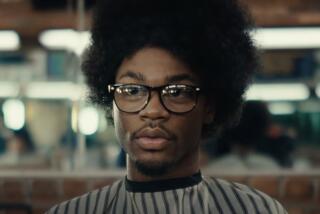Class project yields a feature film with commercial distributors
- Share via
The prospects of finding a distributor for a $220,000 movie, produced mainly by college students at an obscure San Diego Catholic university, could hardly be worse.
But about 60 students at John Paul the Great Catholic University who embarked on a quixotic class project two summers ago to make and release their own movie beat the odds.
With the help of faculty members who had ties in Hollywood, the students recruited professional actors and crew members to help make their film. Students wrote the script — about a terrorist attack that takes place on a Red Line subway in Los Angeles — raised funds and worked behind the camera, finding props and costumes and building sets.
PHOTOS: Hollywood backlot moments
And they accomplished something many independent filmmakers would envy: They managed to secure deals to distribute the movie through iTunes, Amazon.com and Redbox last month. Starting in October, DVDs will be sold through Wal-Mart and Target.
Student film shoots are a common sight in Los Angeles — which has a plethora of local film schools — and occasionally generate more production days than feature films. But most are for film shorts, not full-length feature films, and rarely do those movies find commercial distributors.
“Most industry professionals said it couldn’t be done and that we had no hope of making it look like a professionally produced feature or attracting a stellar cast,” said Dominic Iocco, former dean of the film and media department and a producer on the film. “But we did it and we couldn’t be more proud.”
“Red Line” began as a senior class project that would give film students hands-on knowledge to apply what they learned in the classroom, with the hope they might get a film credit to their names.
“We had this idea that if the students could do a feature film and do it from a commercial standpoint, they would learn more than anything they would get in the classroom,” Iocco said.
ON LOCATION: Where the cameras roll
He and other professors at the small Catholic university challenged students to pitch ideas for a screenplay that could be filmed almost entirely on an enclosed space on the university’s soundstage.
Student Tara Stone, the film’s screenwriter, initially proposed a story about people getting trapped in a wine cellar during the London Blitz in World War II. Shooting a period drama, however, was deemed too expensive. So, at the suggestion of her professors, Stone recast the story to take place in a more contemporary setting of a subway in Los Angeles.
Stone completed a 93-page draft in three weeks.
“It was really hard because while I was writing it I had a full course load,” said Stone, 27, who now works for a film production company. “It was basically, every moment I had I was writing.”
Iocco and his colleagues used their contacts in the industry to attract a professional director (Robert Kirbyson) and working actors, including Nicole Gale Anderson, who has a recurring role on CW’s “Beauty and the Beast” and played Macy Misa on the popular Disney Channel show “Jonas LA,” and Kevin Sizemore, who plays Jared in the television series “Under the Dome.” The actors worked under an ultra-low-budget SAG agreement.
Filmed over 25 days in summer 2011, “Red Line” included some scenes filmed at the Hollywood and Highland subway station. But most of the production was shot on a soundstage at the university, where the students spent several weeks building a replica of a crashed subway car. The students used camera equipment donated by the university’s film program and worked under the guidance of professional department heads, many of whom deferred their fees.
Colleen Monroe, who doubled as the art director and costume designer, worked with a team of 30 students to help build the subway car set. With a budget of just $10,000, Monroe hired a construction crew to build the 75-foot-wide car and scoured junkyards for materials. A junkyard in Riverside donated 15 seats from an old bus, which doubled as subway car seats. Monroe persuaded a demolition company to “donate” a dumpster full of debris to simulate the look of a crashed subway car. She hired a team of makeup artists from the Paul Mitchell hairstyle school in San Diego to work as makeup artists.
Monroe, who now works in the costume design department on HBO’s “Boardwalk Empire,” credits the experience for helping her pursue a career in the movie business. “It definitely gave me the confidence and the contacts to work on bigger projects and helped me start thinking about how I can make a career of this.”
PHOTOS: Celebrities by The Times
The movie was financed through private donations, including friends and family of the students, faculty members and the university itself.
The motto of the school, founded in 2003, is “Impact Culture for Christ.” Most of the students at the small university are film majors. Students also study business and theology.
Although the university supported the film, the movie does not have a specific theological message, said Chris Riley, a producer on the film who teaches screenwriting at John Paul the Great Catholic University.
“I felt like it was in line with the school’s mission,” Riley said. “It looks at ideas that are alive in our national dialogue about torture and what we do to prevent a terrorist attack. It’s a much more humanistic kind of theme.”
More to Read
Sign up for The Envelope
Get exclusive awards season news, in-depth interviews and columnist Glenn Whipp’s must-read analysis straight to your inbox.
You may occasionally receive promotional content from the Los Angeles Times.









